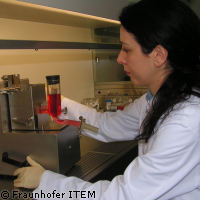Tissue instead of live animal testing to predict toxicity
Researchers from the Fraunhofer Institute for Toxicology and Experimental Medicine (ITEM) are investigating alternative methods to mass animal testing for allergens absorbed through inhalation. The research is part of the Sens-it-iv project, funded under the EU's Sixth Framework Programme (FP6). 'We do not administer chemical substances to live animals to test for allergy risk; instead we use specimens of lung tissue,' explains project manager Dr Armin Braun of the ITEM. This tissue is generally obtained from rodents and cut into very fine slices, so-called precision-cut lung slices (PCLS). It is to these slices that the chemical to be tested is applied. The tissue's reaction is then tested and evaluated. Observing whole sections of the tissue under the microscope, the researchers can see potential interactions between the cells and the immune system, similar to the ones that would occur during an immune response in the body. Currently, the ITEM team is still testing well-known chemicals in order to refine the technique, which they hope will ultimately be employed by the cosmetics, textile and pharmaceutical industry, as well as by public authorities in charge of occupational health and safety. Although the PCLS method still means that animals have to die, 'these in-vitro [test tube] tests performed in a culture vessel require far fewer animals - merely enough to harvest the lung tissue,' the researchers say. In other areas of the Sens-it-iv project, partners from 28 universities, research institutes, and private and public sector organisations are trying to develop in-vitro models based on human skin cells, the overall objective being to identify the key mechanisms of sensitisation while reducing and ultimately abandoning animal experimentation. Testing potential allergens at the level of human lung or skin epithelial cells, dendritic cells and T-cells, the project partners also expect to be able to increase the accuracy of predicting the allergy risk of chemicals. This research, receiving nearly €11 million in EU funding, is particularly important with a view to forthcoming EU legislation: There will be a ban on the testing of cosmetics ingredients on animals after 2009. At the same time, the REACH legislation will require 12,000 chemicals which are already on the market to be tested for toxicity.
Countries
Germany



